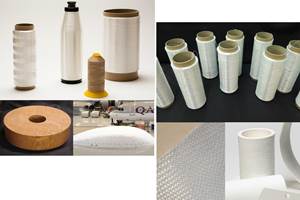Quartz, CMC and ceramic continuous filament offerings
CAMX 2024: Saint-Gobain Quartz, now Saint-Gobain Advanced Ceramic Composites, diversifies its portfolio of high-temperature materials development for aerospace, connectivity and industrial markets.
Share
As of April 2023, Saint-Gobain Quartz (Saint-Pierre-lès-Nemours, France) evolved into a new business, Saint-Gobain Advanced Ceramic Composites (ACC). The goal of this new name is to reflect the company’s ambitions to diversify its solutions and expertise to grow in high-potential markets. Saint-Gobain ACC is implementing a growth strategy focused on quartz, ceramic continuous filaments and ceramic matrix composites (CMC) activities for aerospace, connectivity and industrial markets.
The company’s historical quartz activities will remain a strong focus in its roadmap. Saint-Gobain ACC says it will continue to invest in the development and production of quartz filaments for radomes, electronics, and electrical and thermal insulation in particular.
Quartzel(R) products include 9- or 14-µm-diameter homogeneous, non-porous, continuous, amorphous, ultra-pure silica glass with a SiO2 content >99.95%. Quartzel(R) is available in yarns and rovings processed to varying levels of twist and ply ranging from 17-1,600 tex. This includes chopped fibers and nonwoven textile substrates including wool, felts, needle punch felts veils and powders.
Saint-Gobain ACC’s ceramic continuous filaments activity focuses on a portfolio of solutions based on continuous filaments made of alumina and mullite, dedicated to extreme temperature applications. These filaments are used, for instance, in composites designed to lighten aircraft structures while improving engine efficiency, therefore contributing to a reduced CO2 footprint.
In addition to its historical facilities in Nemours, France, and Louisville, Kentucky, Saint-Gobain ACC welcomes Courtenay, France, into its industrial network for the upcoming production of ceramic continuous filaments.
Related Content
-
The future of quartz and oxide fibers at Saint-Gobain Advanced Ceramic Composites
New business builds on 100-year legacy in quartz, prepares for growth, while starting production of oxide fibers to meet increased demand for CMC by aerospace and industrial sectors.
-
ORNL, Sierra Space create novel C/SiC TPS for reusable space vehicles
CMC tiles will be used on the Sierra Space DC100 Dream Chaser spaceplane carrying critical supplies and science experiments to and from NASA’s ISS.
-
Bombardier begins manufacture of Global 8000 business jet
Ultra-long range business jet featuring CMC-intensive engine and a range of 8,000 nautical miles is set to enter service in second half of 2025 as it remains on track for flight testing.
Related Content
The future of quartz and oxide fibers at Saint-Gobain Advanced Ceramic Composites
New business builds on 100-year legacy in quartz, prepares for growth, while starting production of oxide fibers to meet increased demand for CMC by aerospace and industrial sectors.
Read MoreORNL, Sierra Space create novel C/SiC TPS for reusable space vehicles
CMC tiles will be used on the Sierra Space DC100 Dream Chaser spaceplane carrying critical supplies and science experiments to and from NASA’s ISS.
Read MoreBombardier begins manufacture of Global 8000 business jet
Ultra-long range business jet featuring CMC-intensive engine and a range of 8,000 nautical miles is set to enter service in second half of 2025 as it remains on track for flight testing.
Read MoreNew CMC turbine vanes successfully tested in wind tunnel
SiC/SiC ceramic matrix composite (CMC) inlet guide vanes for a high-pressure turbine are aimed for a geared turbofan and show promise for more efficient aeroengines with less weight and need for cooling.
Read MoreRead Next
Precision blades support industrial fiber cutting needs
CAMX 2024: Machine knives and industrial razor blades supplier American Cutting Edge offers composites manufacturers staple and custom cutting options.
Read More“Structured air” TPS safeguards composite structures
Powered by an 85% air/15% pure polyimide aerogel, Blueshift’s novel material system protects structures during transient thermal events from -200°C to beyond 2400°C for rockets, battery boxes and more.
Read MoreAll-recycled, needle-punched nonwoven CFRP slashes carbon footprint of Formula 2 seat
Dallara and Tenowo collaborate to produce a race-ready Formula 2 seat using recycled carbon fiber, reducing CO2 emissions by 97.5% compared to virgin materials.
Read More













